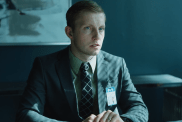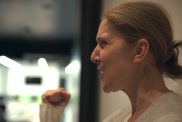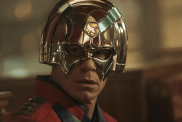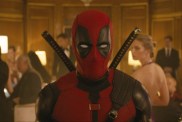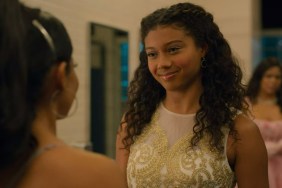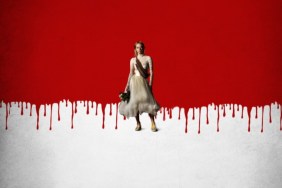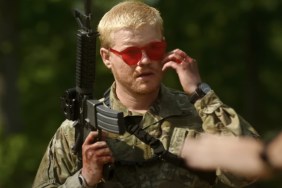First things first, the many people out there who have waited in eager anticipation, and to the many more people who got tired of waiting for the next part in the AVP series; I’d like to apologize for the delay. I’ve been hard at work with a team of equally dedicated people, getting ready for the premiere of my own show later this month on the Cartoon Network, and its been a little hard to turn things in, in a timely manner. I will try not to keep you waiting for another three weeks for the next one.
So with out further delay, ComingSoon.net presents the following interview with noted FX artist, and supervisor of visual effects for Alien vs. Predator: John Bruno. The interview does contain certain story SPOILERS – please proceed with caution.
So what can we look forward to in terms of the way effects are approached in this film?
Well, the approach on this film or historically my approach to visual effects has been every tool in the toolbox works. It’s not just computers; computers are there when you can’t do it any other way. So we use a lot of models and miniatures. For CG, it has to be something a little more special. So there’s giant miniature sets, giant miniature creatures – smaller then the full size creatures. From “Alien,” we’re taking the best of the first and second movies. And from “Predator,” we’re using the first movie as a guide.
Is it difficult to match CG with on set practical effects?
What we’re doing is taking, for example, the Alien and we do have things where we let physics work for you. In other words, we have a tail on the creature and we can see in a rehearsal that the tail won’t do what we want it to do, so we’ll just take it off. And get it to do what you’d like it to do in CG. It’s that kind of thing.
Is it difficult to match up the lighting, etc.?
No, we actually take the time to hold the tail up and get it in the light. That’s why most of it is second unit because we have to take the time to do a lot of clean plate, empty plate, smoke plate, light pass – a lot of things that take a while in first unit.
How many effects are in the film?
Well, 30 pages of the script are visual effects. I’ve never worked on a film like that – I don’t even think “Titanic” had that in terms of percentage of the pages of the script. This is visual effects all the time. I don’t think there’s a sequence that doesn’t have something.
How’d you come to this project?
Through Fox, I got presented with a number of projects. This one I liked; I thought it could be fun.
Sorry about that?
No, I’m not sorry. I’m just tired.
Have there been any changes to the script based on what you can or cannot do?
No changes based on what we can or can’t do; just changes based on schedule. We have to be finished in July.
Is there anything effects-wise that you’re using for the first time?
Nothing. The things that have happened over the past five or six years, there’s better tracking software, there’s better articulation in the full-size Queen. I think the full -size Queen has 50 percent more points of articulation then the “Jurassic Park” T-Rex. It really works good and its very movement oriented. You can get it into almost any position you want. The same thing with the hydraulic Alien warrior. But as far as visual effects now, we used to spend a lot of time making green and blue screens perfect. Now we just throw up something to shoot. We spend all our time putting markers everywhere so the camera can move freely, which is what used to give away special effects when the camera would be locked down. Not anymore.

Have you worked with Woodruff and Guinness before?
I’ve worked with them in the past and I’ve known them for years. They go back to “Alien”. I worked with them when I did a little stint on “Alien 3”. I came up with three different endings so the studio could test them and settle on one. We get along great; they do terrific work. And they’re fun.
What has been your biggest challenge on the film?
Well, coming up with the Predator cloaking We’re doing some spectacular things in this film. We’re not just having the Predator stopping, then the dissolve comes. We have him leaping a 25-foot gap in the Chamber of Gods and while in mid-air he disappears, but the camera still follows him. It’s very complex motion control – repeatable passes. It takes a long time and there’s a lot of pressure. But it’s going to look fantastic. We’ve already got some rough cuts together and it looks really good. Getting to see every aspect and every minute detail of how a face-hugger leaps – we shot it at 300 frames a second. It’s all CG – the face hugger leaps across the room. So there’s a scene where they’ll all be flying and you’ll get to study them a bit – like flying squirrels, they’re lining up their targets. I already saw the rough cuts on that and we’ve got some pre-visualizations that look really good.
What about the Predator vision?
Predator vision we’ve basically pushed much farther. We studied the first one – we don’t want to do something that’s completely not the same, but we’ve got four stages of it. What Predator vision was in the first two movies was basically an optical, hand-animated pattern over a live action image. We’re taking that as a look, but we’ve basically found a military grade heat sensing technology that actually does that and it looks pretty spectacular. But that’s when we’re in wide shots. We’re going to enhance that somewhat and we’re doing it in 3-D layers. When the Predator is looking for specific things – he goes inside Weyland, looking at his physical stature – and by going into his body and looking at his organs he can tell that this guy’s not worth the fight and just leaves him behind. So we’re doing that sort of thing. Muscles, bones, and organs.
What shot are you working on right now?
There’s a trailer shot we’re working on. It’s a flashback that tells the story. The actors are reading hieroglyphs – interpreting hieroglyphs – to find out what’s been going on here and why this whole pyramid exists. There’s this one shot which we’ll do for the next publicity run is a pull back They’re sort of interpreting the hieroglyphs and it says, “When things were going right, they were really right. But when they went wrong ” We cut to three Predators on top of a pyramid, stormy sky, lightning, completely covered in Alien blood. They’re smoking and steaming – it’s kind of a Frazetta shot – a big pile of Alien parts. The camera pulls back from the top of this pyramid and you see thousands upon thousands of Aliens. They’re done. You just keep pulling back and you see this entire pyramid overrun by Aliens. And then they activate their bomb, which is what happened to the Incas. Where did those people go? They just disappeared one day.
Will all the characters be CG in that shot?
Well, the Aliens will. There’s no way to do that many because we only have four suits.
Do you think that the viewers are more sophisticated nowadays and can pick up more easily on special effects?
Viewers are more sophisticated, that’s for sure. But I always take the approach that I still want to see realistic visual effects. So I probably work a little harder then I should to try to make things look more realistic because in theory you can do a whole show in CG, but I think it looks it. So you just have to pick your sequences and how much of a percentage of that can you do for real. My approach, having been with Jim Cameron for years, is how do we do it real? Even if it means build a big model and hang it between the character and the camera so that its still being lit by light. Real is best and if you can’t do it any other way then you start dropping in the CG. But, of course, computers composite better, so you can have as many layers as you want. That’s the big jump over optical – digitally you can have a thousand layers.

What are the challenges of shooting an Alien?
The whole point of Aliens is not to light them. If you look at all the movies you never see much. So you never want to show too much. Alex, the editor, is doing a really good job of showing bits and pieces. It is rubber and if you light it, it will look like rubber. So you have to move it fast, grease it up, and backlight it. Sometimes its three frames of an edit that will make it look good.
What about the Predator?
The Predator looks good all the time, except he’s blind. He can’t see where he’s going. You know it’s really funny. I was standing there looking at this guy who’s seven feet tall and loaded with all of this gear and you’re thinking you’re looking at a monster and then you hear, “[In a timid voice] Can you get me a drink of water, please?” Ian is really agile in the suit, except it’s hard to get him to run down stairs because he can’t see. So there’s a lot of working out those kinds of problems.
The Predator has a lot of weapons. How many of those are CG?
We have to make the blades – there are bigger blades this time – so we have to have them pop out in CG. There’s no other way to do it. The same thing with the flying disc – it pops out blades. They have the end position and the empty position; we do the rest. The spears do the same thing.
Do directors have to get up to speed on the latest in visual effects?
Generally, yes. On this film, I storyboarded I got a team of guys together and we storyboarded the whole thing, and we’re still storyboarding. So that’s what I do on Sundays.
Which creature do you like best?
I like the Predator. Alien I don’t want to see; I don’t care how good it is, you just don’t want to see it. You want it to be as mysterious as it always was. Like in the fourth movie you saw it swimming around and I thought, “I don’t want to see that.” Yeah, we’re taking care as to when you see it and how much you see. It’s a big issue that everyone keeps arguing over. You get used to seeing it and then you think its OK, but you shouldn’t see it even if it’s right in your face.
Do you like the Predator because it’s more human-like?
Probably. We keep asking, “Is the Alien an insect?” It’s kind of got human traits to it. It’s kind of a chit in the shell – more spider-like. And you still don’t want to do things that make the Predator human. It’s easy to fall into that. Predator should not be human; it’s a reptile. I keep on telling everybody it’s a fruit-eater, but its just angrier because there’s not any fruit wherever he’s going. But that’s a constant discussion – is this too human a move? Is he reacting too human? We’re just prey – part of the game. The Aliens, their whole cycle is reproduction. That’s all they’re doing. They don’t even care who we are; were just part of their process.
So how do you compensate?
There’s this great shot with somewhat of an explosion near the end and Paul and I would have this discussion, “This guy is a Predator. All he would do is stand there and take it.” If you think of an iguana, an iguana would just stare at something because it doesn’t know what else to do. So basically in this chase sequence, there’s an explosion and Lex covers herself but the Predator just stands there and looks at the explosion as it flies by him. That’s not human. Those are the discussions we continually have because day after day you can fall into, “Well, that looked good. But what is the rule?”

What’s been the biggest challenge?
Well, I thought the face huggers were going to be a big challenge, but that went really well. And then I was really nervous about Predator vision until we saw the first two sequences. Then I was nervous when we were doing cloaking, and that looks good. So the things that are supposed to be really easy, I’m sure they’re going to be a nightmare. Our ending is very challenging. There’s reconfiguration sequences where the pyramid every 10 minutes reconfigures so just when you think, “Boy, I defeated that Alien or got away from that Predator” the entire internal mechanism of the pyramid reconfigures and becomes a different place with a different exits and you don’t know where you’re going. That will be all CG interacting with some practical moving walls. But that’s all happening at the same time that the Predator is attacking our characters. He’s leaping across the room going into cloak mode as the room keeps moving. So it’s a nightmare scene.
One last question. How do you like working with Paul?
Paul’s great. He’s like this 17-year-old kid. He’s really into this stuff. This was his idea to do this version. I know there’s been like 10 versions that the people have been pitching for the past 10 years. So this is a good thing for Paul. He’s very open to suggestion from me, so that helps. I don’t feel like I’m up against a wall. Whenever you need him, he’s here.
Special thanks to Eric Moro, for providing the written transcript.

